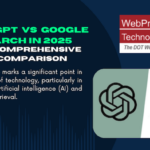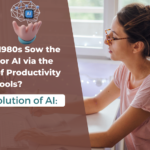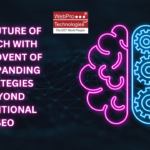Introduction
The 1980s were a transformative decade in the history of computing, marked by the introduction of productivity tools that revolutionized the way people worked. These tools, including Microsoft Word, Excel, Lotus 1-2-3, and PowerPoint, laid the groundwork for the sophisticated, AI-powered software we see today. While these early productivity tools were not AI-powered in the way we understand AI today, they did sow the seeds for the development of artificial intelligence by promoting the widespread use of personal computers and fostering a culture of innovation and automation.
The Technological Landscape of the 1980s
The Rise of Personal Computers
The 1980s saw the proliferation of personal computers, making computing power accessible to a broader audience. Companies like IBM, Apple, and Microsoft played pivotal roles in this transformation. IBM's introduction of the IBM PC in 1981, followed by Apple's Macintosh in 1984, brought computing into homes and offices worldwide.
Productivity Tools: The Catalyst for Change
During this period, productivity tools such as Microsoft Word (1983), Excel (1985), Lotus 1-2-3 (1983), and PowerPoint (1987) emerged as essential applications for personal and business use. These tools democratized access to powerful computing capabilities, enabling users to perform tasks that previously required specialized equipment and expertise.
The Foundations of AI in the 1980s
While the primary focus of productivity tools in the 1980s was to enhance efficiency and streamline tasks, several underlying technological advancements during this period contributed to the evolution of AI:
Data Management and Automation
One of the key features of productivity tools was their ability to manage and manipulate data efficiently. Excel and Lotus 1-2-3, for instance, introduced advanced spreadsheet functionalities, including formulas, macros, and pivot tables. These features allowed users to automate repetitive tasks and perform complex calculations, laying the groundwork for future AI-driven data analysis and automation.
User Interface and Usability
The graphical user interface (GUI) introduced by applications like Microsoft Word and the Macintosh OS made computers more accessible to non-technical users. This focus on usability and user experience set the stage for the development of AI-driven interfaces that prioritize user-centric design and interaction.
Early Natural Language Processing
Although rudimentary, early productivity tools included basic natural language processing (NLP) features. For example, Microsoft Word introduced spell check and grammar check functions, which were early forms of NLP. These initial steps in processing and understanding human language paved the way for more advanced NLP applications in AI.
Integration and Interoperability
The 1980s also saw the development of integrated software suites, such as Microsoft Office, which combined word processing, spreadsheets, and presentation tools into a single package. This integration facilitated seamless data exchange and interoperability between applications, a concept that would later be crucial for AI systems that rely on diverse data sources and interconnected processes.
The Evolution of AI: Key Milestones
The advancements made in the 1980s set the stage for significant developments in AI over the following decades. Here are some key milestones in the evolution of AI:
The 1990s: The Dawn of Machine Learning
The 1990s saw the emergence of machine learning as a key area of AI research. Advances in algorithms, computing power, and data availability allowed researchers to develop models that could learn from data and improve over time. This period also witnessed the development of AI applications in fields such as natural language processing, computer vision, and robotics.
The 2000s: The Rise of Big Data and Cloud Computing
The 2000s marked the rise of big data and cloud computing, which provided the infrastructure needed to process and analyze vast amounts of data. Companies like Google, Amazon, and Microsoft developed cloud platforms that enabled businesses to leverage AI technologies without investing in expensive hardware. The availability of large datasets and powerful computing resources accelerated the development and deployment of AI applications.
The 2010s: The Era of Deep Learning
The 2010s saw the advent of deep learning, a subset of machine learning that uses neural networks with many layers to model complex patterns in data. Breakthroughs in deep learning led to significant improvements in image and speech recognition, natural language processing, and autonomous systems. AI-powered tools like virtual assistants (e.g., Siri, Alexa), recommendation systems, and self-driving cars became a reality.
The 2020s and Beyond: AI Ubiquity and Ethical Considerations
As we move into the 2020s, AI continues to permeate various aspects of our lives. From healthcare and finance to education and entertainment, AI-powered applications are becoming increasingly ubiquitous. However, this widespread adoption also raises important ethical considerations, such as data privacy, algorithmic bias, and the impact of AI on employment. Addressing these challenges is crucial for ensuring the responsible and equitable development of AI technologies.
The Role of Productivity Tools in AI Development
While productivity tools from the 1980s were not AI-powered, they played a crucial role in the development of AI by:
Driving Technological Innovation
The success of productivity tools created a demand for more advanced computing capabilities and spurred innovation in software development. Companies like Microsoft, Apple, and IBM invested heavily in research and development, leading to breakthroughs in computer science and AI.
Fostering a Culture of Automation
Productivity tools introduced users to the concept of automation, enabling them to perform tasks more efficiently and accurately. This experience with automation laid the groundwork for the acceptance and adoption of AI technologies that automate complex processes and decision-making.
Generating Data for AI Training
The widespread use of productivity tools generated vast amounts of data, which became a valuable resource for training AI models. For example, data from spreadsheets, documents, and presentations provided insights into human behavior and decision-making, which could be used to develop more intelligent AI systems.
Enhancing Human-Computer Interaction
The emphasis on usability and user experience in productivity tools influenced the design of AI-driven interfaces. AI applications today prioritize intuitive interactions and user-centric design, building on the foundations established by early productivity tools.
Conclusion
The 1980s were a transformative decade that laid the groundwork for the evolution of AI. The advent of productivity tools like Microsoft Word, Excel, Lotus 1-2-3, and PowerPoint revolutionized the way people worked and set the stage for future technological advancements. While these tools were not AI-powered in the modern sense, they introduced concepts of automation, data management, and user-friendly interfaces that would become essential for AI development.
Me as a faculty member who taught Fortran, COBOL, and BASIC, have vivid memories of the time when we first encountered the revolutionary productivity tools like Microsoft Office and dBASE (The first database management systems for microcomputers). These new application software packages brought a transformative shift in how we approached computing and data management.
When Microsoft Office made its debut, it introduced us to a suite of tools that simplified tasks we had long performed using traditional programming languages. Word processing, spreadsheet management, and presentations became more accessible and user-friendly. Similarly, dBASE offered powerful database management capabilities that streamlined data handling processes.
This transition was both exciting and challenging. On one hand, these tools opened up new possibilities for efficiency and collaboration. On the other hand, they rendered some of our skills less critical. We felt a need to adapt quickly to keep pace with the evolving technological landscape.
The sense of redundancy was palpable. The intricate knowledge of Fortran, COBOL, and BASIC, which had been our mainstay, seemed less crucial in the face of these new, more intuitive applications. It became evident that to remain relevant and effective, we needed to embrace and master these productivity tools. This shift not only expanded our technical repertoire but also underscored the importance of continual learning and adaptation in the ever-evolving field of technology.
As we look to the future, it's clear that the seeds sown in the 1980s have blossomed into a vibrant ecosystem of AI-powered applications that continue to transform our lives. By understanding the historical context and evolution of these technologies, we can better appreciate the incredible potential of AI and work towards a future where AI is used responsibly and equitably to benefit all of humanity.
September 1, 2024






